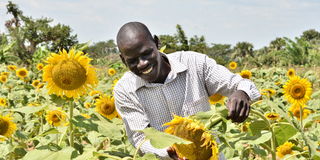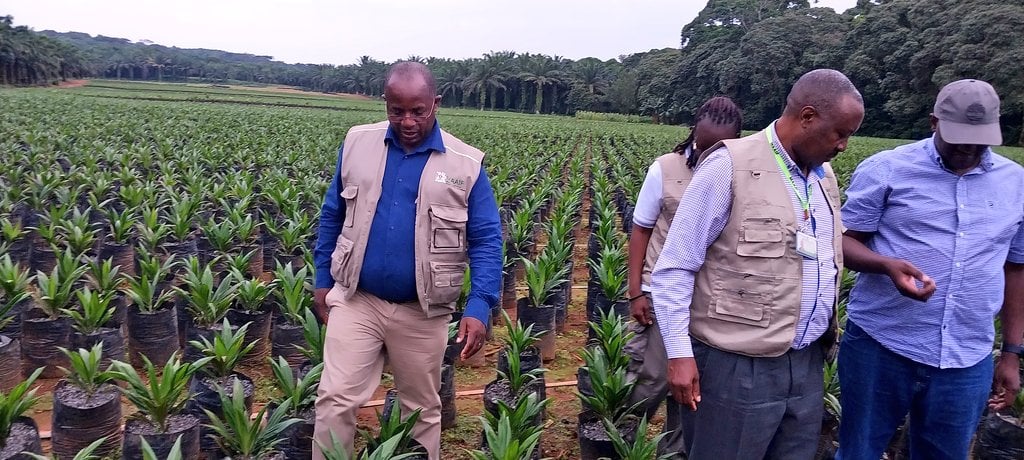Prime
Improved seeds give Okore hope

Okore is now a happy farmer after adapting hybrid sunflower varieties. PHOTO | GEORGE KATONGOLE
What you need to know:
- The Uganda government established a program to subsidise inputs through an emergency intervention under the National Agricultural Advisory Services (Naads), giving farmers higher yielding hybrid seeds.
Ronald Okore, 34, has lived all his life in Alel Village, Agali Sub-County, Lira District.
His farming journey has been full of frustrations.
“I have been growing several crops but the harvest was always frustrating,” Says Okore, a member of Agali Farmers’ Cooperative Society.
On his one and a half acres, Okore has been growing mainly soybean and other grains for domestic consumption as well as food crops.
Last year, during the first planting season, Okore planted maize but without exaggeration, he says, the harvest was half a bag.
“My friends advised me to plant trees on the land because it was unproductive,” he says.
Help on the way
That is the thought he harboured until the cooperative received seeds from the National Agricultural Advisory Services (Naads) through the emergency intervention to plant oilseeds.
Agali Farmers’ Cooperative Society, which was founded in 2005, has been helping maximise the production of oilseeds. The cooperative has a membership of 2,700 farmers spread in Dokolo, Lira and Alebtong Districts.
The cooperative engages farmers in primary production and has been collecting between 1,000-2,000 metric tonnes per season.
But the cooperative manager Peter Tempa says that with off takers such as Mukwano, there is a lot of demand for large quantities of soybean and sunflower.
When Naads intervened, the cooperative received 3,440kg of sunflower seed which they distributed among farmers. Most of the seed was planted with only 270kg remaining in store for the upcoming planting season.
Okore was among the farmers, who received the seed which will be co-funded either by seed at harvest or cash.
Improved seeds
In the past, Okore, reports that the poor quality seeds were partly to blame for the poor harvest.
“I have been using the locally produced local seeds and they have not been yielding well. But now we received improved seeds and I am happy they are promising a great harvest looking at the sunflower heads,” says Okore.
The new sunflower varieties include; pannar seed, Hysun 33 and Agsun while the two preferred soya varieties are Maksoy 3N and Maksoy 6N.
The new hybrid seed varieties have a high germination rate and offer an excellent yield as well as superior oil content.
Scientists also say it is highly adaptable and are quicker flowering which helps manage the risk of Sclerotinia infection.
Dr Charles Aber, a Crop Development Specialist with Naads explains that with good agronomic practices, farmers can get full benefits of the hybrid seeds.
“We are intent on having farmers get the best seed with high oil content to be able to fill the edible oils gap,” Dr Aber says.
Okore, as other farmers in his cooperative, planted three kilos of Hysun and at the end of this season, which is expected staring late December through the early weeks of January, Okore expects to harvest about 800kg. At the farm gate price of Shs1,200, Okore expects to earn at least Shs960,000 of which about Shs90,000 will be remitted for co-sharing costs. Compared to the past experiences this is a step up.
Good practices
Dr Aber explains that quality seed combined with good agronomic practices is desired to bridge the gap.
He says that most sunflower farmers make losses at harvesting which can be avoided.
He says sunflowers, when mature, the back of the head turns from green to yellow and the circumferential bracts begin to brown and become brittle.
The crop can be harvested when the back of the heads is still slightly moist. Losses during the harvesting process are thereby significantly reduced.
The harvesting process can start when the moisture content of the seed is 12.5 percent. However, sunflower seeds that need to be stored must have a moisture content of less than 10 percent, otherwise fungi can build up within 48 hours after being dumped in a heap.
There is also a risk that the seed may spontaneously combust at higher moisture percentages. Optimal moisture content for storage is 9.5 percent if the seed must be stored in a silo for months. It must also be continuously aerated or moved from silo to silo to prevent the build-up of fungi.




